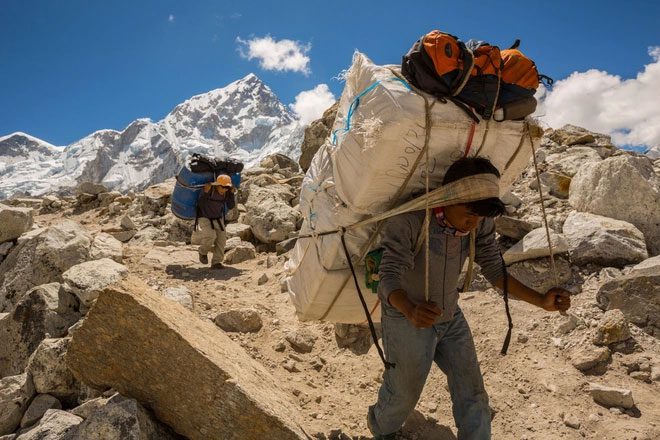Thanks to genetics or through training, even ordinary people can develop superpowers.
Superpowers are real in life. While we cannot grow giant claws like Wolverine from the science fiction film X-Men or shoot energy beams from our eyes like Cyclops, the human body and brain have the potential to achieve extraordinary feats.
Sometimes superpowers emerge through genetic mutations. For example, the Sherpa people in the Himalayas have adapted to high altitudes thanks to genes that enhance their strength and endurance.
The Bajau people in the Philippines, Malaysia, and Indonesia have developed genetic abilities to use oxygen more efficiently. This allows them to become exceptional free divers, “nomads” of the ocean, capable of diving for up to 4 minutes without any breathing apparatus.

Superpowers are real in life.
Other superpowers are entirely achievable by us. Memory athletes demonstrate astonishing feats of recall, prompting us to wonder how they can perform such extraordinary mental accomplishments.
Even fear can be conquered given the right conditions, as seen in the story of rock climber Alex Honnold, who is compared to Spider-Man for his ability to climb sheer rock walls without any safety ropes.
Scientists have begun to explore what is happening inside the bodies and minds of individuals with these capabilities. They found that while genes give some individuals an advantage, most of them possess untapped potential.
These are just a few examples of the hidden superheroes within our bodies.
Overcoming Fear
For most people, just looking at a photo of Alex Honnold hanging off a cliff by his fingertips is enough to make their brains tremble with fear.
Researchers scanned his brain and made a surprising discovery. The analysis of activity in the amygdala – the part of the brain associated with fear – showed that Honnold’s amygdala was completely silent.
Structurally, his brain is entirely normal, and Honnold has long denied that he feels no fear.
Neuroscientist Jane Joseph examined Alex Honnold’s brain activity and revealed that he has self-imposed limitations on certain brain functions by focusing meticulously on executing each climbing action.
This is a superpower we all can tap into. Psychologists use similar conditioning methods to help people overcome their fears, and neuroscience is revealing how the memory of fear is formed and can be erased.
Resilience
Genetic researcher and physiologist Tatum Simonson from the University of California (USA) states: “Humans are still evolving,” and the Sherpa people in Nepal are a perfect example of superpower development.
This community has lived for over 6,000 years at an average altitude of 4,200 meters, where the oxygen level is about 40% lower than at sea level.
Simonson explains: “Natural selection has found optimal ways to help these people adapt to low oxygen conditions.”

Sherpas carrying goods from farms on top of Everest (the highest mountain in the world) down to the villages in Gorak Shep, Nepal for storage. After thousands of years living in high altitudes, they have developed genetic mutations that allow them to use oxygen more efficiently.
Typically, when oxygen levels drop, the human body pumps more oxygen-carrying red blood cells, but this thickens the blood and can lead to altitude sickness or even death.
In contrast, the Sherpa have developed certain genetic mutations that allow them to maintain lower red blood cell levels, while the mitochondria in their cells can still use oxygen more efficiently.
Simonson is studying the Tibetans living at lower altitudes and has found that they maintain their advantages even at sea level. This is a superpower, and scientists hope to learn from this to help those suffering from chronic hypoxemia due to respiratory or cardiovascular diseases.
“Nomads” of the Ocean
There’s a reason we love superheroes who can soar high like Superman or dive deep into the ocean like Aquaman: they can reach places we cannot.
For free divers, they do not need diving equipment to plunge to the depths of the ocean. A prime example is the Bajau people in the Philippines, Malaysia, and Indonesia, who exemplify this superpower. They can survive underwater for up to 13 minutes at depths of 70 meters.
Scientists say that, similar to the Sherpa example above, the Bajau community has developed genetic advantages to use oxygen more efficiently. However, because they face more immediate oxygen deprivation, the Bajau have developed a faster mechanism.
Over time, natural selection has led to the development of a larger spleen in their bodies – where oxygenated red blood cells are stored. While diving, their spleen contracts and releases this reserve into the bloodstream.
As Fast as Lightning
In fiction, mythical creatures like vampires and werewolves are imbued with super agility, moving with extraordinary balance and reflexes.
In real life, a combination of genetics and training has given some people superhuman speed.
Swordmaster Isao Machii is a prime example. Isao Machii can use a Katana sword to slice a plastic bullet flying towards him at a speed of 322 km/h in half.
Another example is legendary sharpshooter Bob Munden, who has been tested for his ability to draw his gun and hit a target in less than 1/10 of a second, faster than the reaction time of an average human brain.

Swordmaster Isao Machii.
Scientists are still striving to understand how the central nervous system enables humans to plan and execute complex movements unconsciously.
Extraordinary Memory
Imagine being able to memorize the order of a deck of cards in 20 seconds or remember the names and faces of hundreds of strangers in just a few minutes. For competitors in the USA Memory Championship, achieving these feats is entirely possible.
However, there is nothing extraordinary about memory champions, other than the fact that they have trained extensively. Scientists say anyone can improve their memory – at any age.
Many studies are underway to explore how memory training affects brain activity. Some discoveries reveal how memory techniques work, accomplished by forming networks in the brain that connect new memories with old ones.
Furthermore, a study published in the journal Neuron shows that ordinary individuals can significantly improve their memory after just 6 weeks of training. Superpowers are within reach for all of us; with a little effort and persistent practice, they can become a reality.


















































